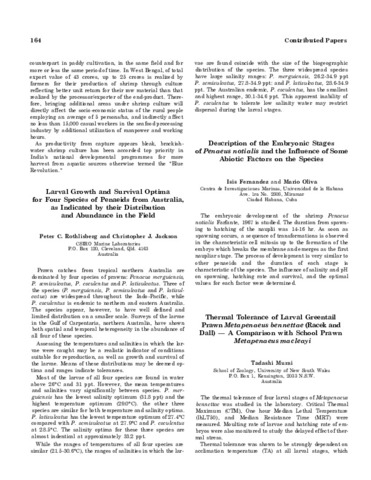Sensitivity of grouper Epinephelus coioides eggs to handling stress at different stages of embryonic development
- Global styles
- MLA
- Vancouver
- Elsevier - Harvard
- APA
- Help
Share
抄録
The sensitivity of grouper Epinephelus coioides eggs to handling stress at different stages of embryonic development was investigated. Naturally-spawned grouper eggs in floating net cages were collected and handled at the early cleavage, blastula, gastrula, neurula, and eyed stages. Egg viability, hatching rate and percentage of normal larvae were significantly higher (p<0.05) in eggs collected and stocked at the eyed stage than in all other stages. An increasing sensitivity to handling stress was observed in eggs from early cleavage to gastrula, as manifested by the decreasing percentage of viable eggs, hatched, and normal larvae. Sensitivity to handling stress decreased when development reached the neurula and eyed stages. Hatched larvae from eggs handled during the blastula and gastrula stages had high mortalities during the first 3-24 hours after stocking. The results of this study show that grouper E. coioides eggs are most sensitive to handling stress during the early cleavage to gastrula phases. The results imply that harvesting or collection of grouper eggs is best done after neurulation, when the embryo has already formed optic vesicles (eyed stage), to increase egg viability and the hatching rate. It will also minimize mortalities and the occurence of abnormal larvae.
Suggested Citation
Caberoy, N. B., & Quinitio, G. F. (1998). Sensitivity of grouper Epinephelus coioides eggs to handling stress at different stages of embryonic development. The Israeli Journal of Aquaculture-Bamidgeh , 50(4), 167-173. http://hdl.handle.net/10862/1758
Type
ArticleISSN
0792-156XCollections
- Journal Articles [1256]
Related items
Showing items related by title, author, creator and subject.
-
Embryonic and larval development of hatchery-reared silver therapon Leiopotherapon plumbeus (Perciformes: Terapontidae)
Aya, Frolan ; Nillasca, Vicar Stella N.; Garcia, Luis Maria
; Nillasca, Vicar Stella N.; Garcia, Luis Maria  ; Takagi, Yasuaki (Springer Verlag, 2016)
The embryonic and larval development of hatchery-reared silver therapon Leiopotherapon plumbeus are described to provide essential information on the early life history of this species. Egg size, larval size at hatching, ...
; Takagi, Yasuaki (Springer Verlag, 2016)
The embryonic and larval development of hatchery-reared silver therapon Leiopotherapon plumbeus are described to provide essential information on the early life history of this species. Egg size, larval size at hatching, ... -
Description of the embryonic stages of Penaeus notialis and the influence of some abiotic factors on the species
Fernandez, Isis; Oliva, Mario (Aquaculture Department, Southeast Asian Fisheries Development Center, 1985)The embryonic development of the shrimp Penaeus notialis Farfante, 1967 is studied. The duration from spawning to hatching of the nauplii was 14-16 hr. As soon as spawning occurs, a sequence of transformations is observed ... -
Hormone-induced spawning and embryonic development of the rabbitfish, Siganus vermiculatus (Pisces: Siganidae)
Avila, Enrique M. (San Carlos Publications, University of San Carlos, 1984)Induced spawning experiments were conducted on captive Siganus vermiculatus with the use of human chorionic gonadotropin (HCG APL Ayerst). The hormone was administered intramuscularly and the intraovarioan oocyte development ...





